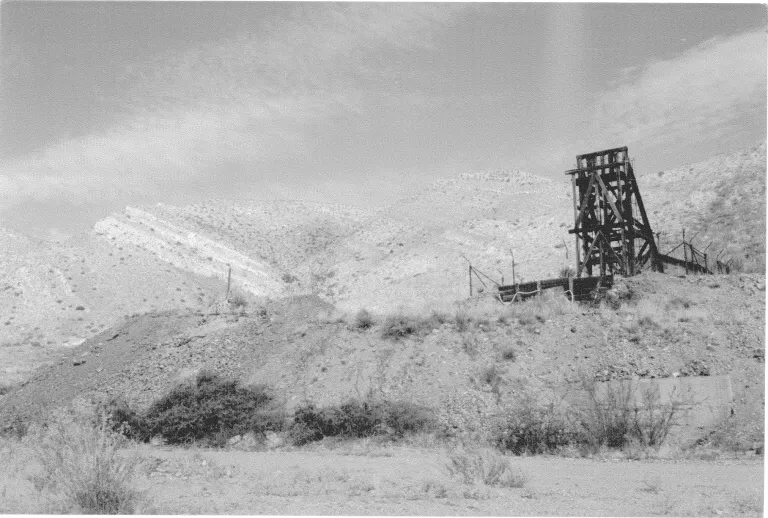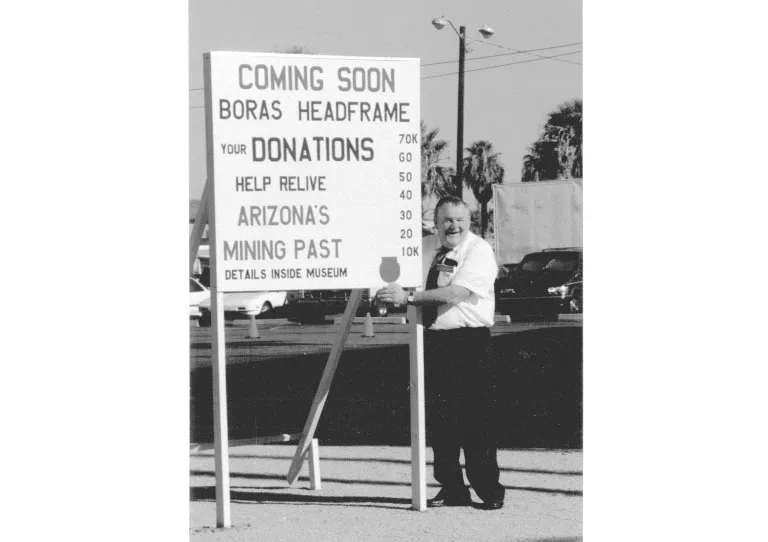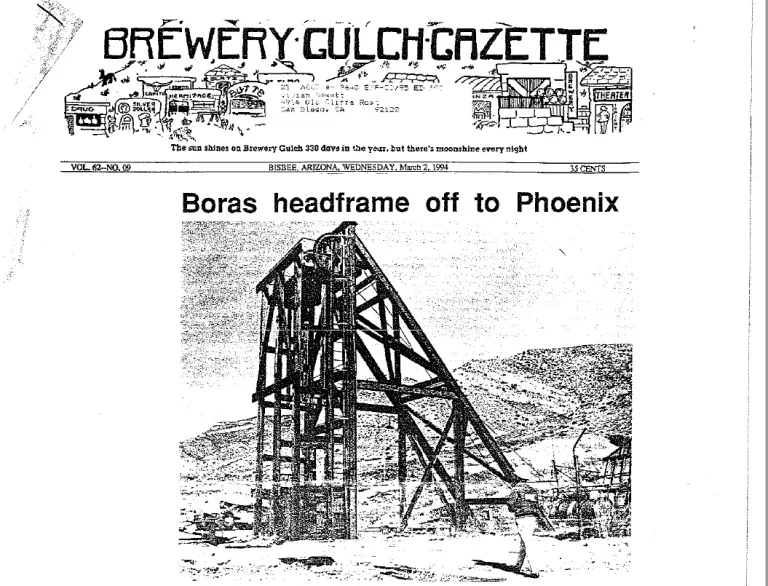Museum History: The Boras Headframe

One of the most significant and recognizable landmarks on our museum grounds is the Boras headframe, a towering wood and steel structure located on the west side of the grounds between the museum building and the Arizona Department of Administration building. The headframe has a long and interesting history. It was originally located in the Mule Mountains near Bisbee, AZ and dates back to mining operations over 100 years ago. It has resided on the museum grounds since the 1990s, thanks to the efforts of Charlie Connell and the volunteer Monday Crew.

The Boras Headframe in the Mule Mountains near Bisbee, AZ.
So what is a headframe? It is the structural frame that sits above the entrance to an underground mine shaft. The headframe supports the hoist and cables which facilitate entrance into the shaft and lift out miners and mined ore.
The Boras headframe, seen above at its original location in the Mule Mountains of Cochise County, was originally constructed for the purpose of sinking an exploration shaft in 1917. It was not meant to be permanent; if the exploration program was successful then the headframe would be replaced with a permanent one and equipped with a production mine hoist. However, a new headframe was never built and the existing Boras Headframe supported operations at the Boras shaft intermittently from 1917 to 1975.
The shaft reached a depth of 1034 feet, and drifts at the 400 and 600 levels intercepted high-grade orebodies in 1919. From 1917 to 1926, about 50,000 tons of copper ore were shipped to the Douglas smelter. Mining halted during the Great Depression but resumed from 1938 until 1944 when the ore was exhausted. Since drifts at the Boras shaft connected with the workings of the nearby Cole and Dallas mines, it then served as a ventilation and escape shaft for workers at those mines in the 1950s. Since the headframe was originally constructed with wood, it was reinforced at that time with steel to preserve it as an escape shaft and remained useable until mining ended in 1975.

Mason Coggin, director of Arizona Department of Mines and Mineral Resources during the mid 1990s, with a fundraising sign outside the museum.
In 1992, Phelps Dodge Corporation (now Freeport-McMoRan) officially donated the Boras headframe to the Arizona Mining and Mineral Museum, which had moved to its new location on the Capitol Mall in 1991. The museum then began a fundraising campaign to move the headframe to its new home. This campaign consisted of historic preservation grants, support from nonprofit organizations, and donations from the public. Soon the headframe was ready to begin its journey to the museum.

Front page news of Bisbee's Brewery Gulch Gazette on March 2, 1994. The caption reads, "John Zamar, area manager for Bisbee for Phelps Dodge Corporation, looks over the Boras headframe, which sits on the south slope of the Mule Mountains, overlooking Don Luis. Phelps Dodge has donated the headframe to the Arizona Mining and Mineral MUseum in Phoenix. The Museum is now raising money to help with the relocation of the landmark, which is one of the last timber headframes in the nation. (Photo by RIchard Byrd.)"
Starting in 1994, volunteer and millman Charlie Connell began the three-year effort to move the giant wooden structure, along with its hoist house, piece-by-piece to the museum grounds at 1502 W. Washington. This was a labor-intensive and expensive process that would include dismantling the headframe at its site in the Mule Mountains, packing up the components, transporting them over 200 miles to Phoenix, excavating and preparing the site on the museum grounds, and carefully reassembling the structure at its new home.
Here's an excerpt of a 1994 writeup by Frank Hendricks and Charlie Connell about the process:
THE BORAS MANUEVER
by Frank Hendricks and Charlie Connell
At long last the big day arrived! On November 1 of this year and with the help of Phelps-Dodge, Arizona Public Service (APS) equipment and personnel, ladders, cranes, bucket trucks, MCO personnel, grinders, welders, chains, bracing, cribbing timbers, and tractor-trailers, the BORAS headframe and equipment started its 200 mile journey to the Arizona Mining and Mineral Museum in Phoenix.
Packing up the BORAS for its move was no small feat considering the size and weight of the component parts. For instance, the hoist weighed in at 19,600 lbs, two sheave wheels at 1,000 lbs each, and a piece of the foreframe the went 13,400 lbs. A 35 ton APS crane was required to lift and load the heavy parts. Everything had to be braced or supported before it could be lifted an moved. The huge timbered frames were laid down as gently as a box of eggs. Two 40 ft APS flatbed trailed trucks were piled high with as much material as they would hold and on November 5, the trucks pulled out of Bisbee headed for Phoenix. The convoy did not actually reach the museum until November 8 at about 3:00pm. On November 9, the trucks were unloaded and the BORAS headframe had reached its new home. There was still a large amount of loose wood and other components remaining at Bisbee and on December 12th the Museum sent a rack truck to gather up the last of the items. The crew was pleasantly surprised to find Phelps-Dodge had banded all of the materials together making the loading much easier. On December 16, the last of the BORAS material arrived at the museum.
So, now that the BORAS headframe is here, now what? The first stage will be to excavate the site and pout concrete foundations for the "collar." Once a firm foundation has been constructed, the BORAS headframe will be restored a piece at a time, in the reverse order that it was dismantled. Each piece has been numbered and charted. Like a giant jigsaw puzzle, the pieces must all fit together just as they originally stood. The hoist must be mounted and the hoist house reconstructed. Finally, when everything has been put together, the cables will be pulled through the sheave wheels and the BORAS headframe will stand just as it once did over the BORAS shaft in Bisbee.
Back in Bisbee, where the headframe once stood, there is nothing. The last sign of man, the towering headframe, is gone. The desert will soon take back its own. The mass of iron and timber now takes on a new significance. The BORAS headframe is a part of history that will be looked at and wondered at by schoolchildren and adults alike. The museum is fortunate to have obtained this piece of history and we are fortunate that the museum will preserve the BORAS headframe for all to enjoy, as a symbol of Arizona's mining heritage. This structure will receive much recognition from the visitors that come to the museum. Since 1987, more than 160,000 visitors and over 60,000 students have toured the museum.

The headframe as it stands today.

Another view of the headframe (right) looking west from the top of the Swallow Mine stamp mill. In the background is the Arizona Capitol Museum building and Governor's Executive Tower.
Today, the Boras headframe still stands proudly next to our museum, just a short walk from the Arizona Capitol. If you're interested in seeing it in person, you can view the headframe from Washington Street. It is still maintained along with the other mining equipment exhibits by Charlie Connell and the Monday Crew volunteers, and we hope to incorporate it into future exhibits showcasing Arizona's mining history for the new museum.

